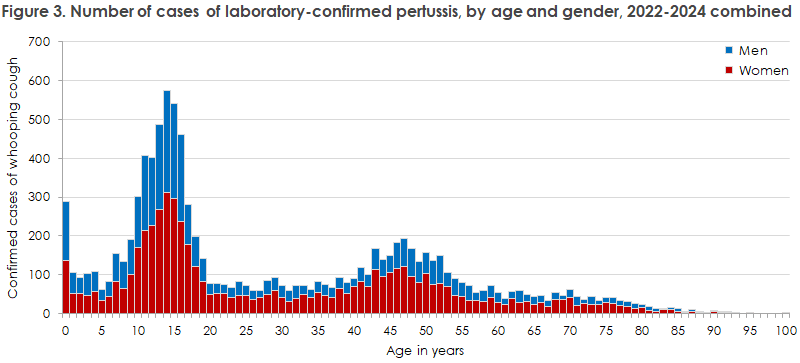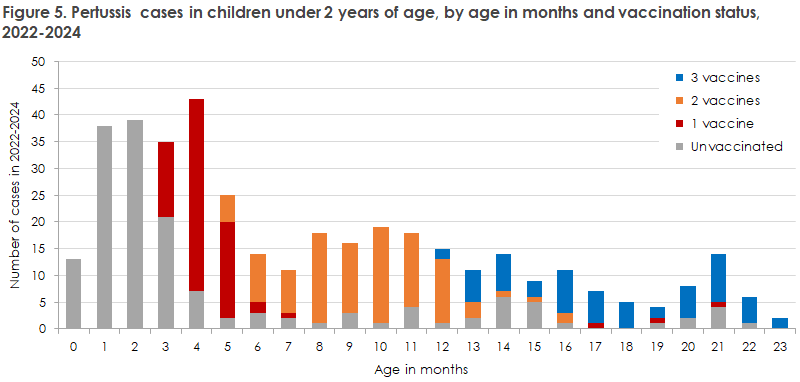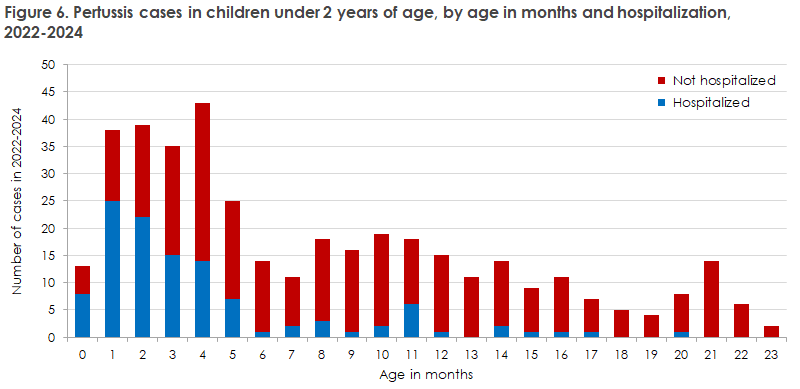Whooping cough - annual report on disease incidence 2022-2024
Whooping cough – annual report on disease incidence 2022–2024
Overview
During and immediately after the COVID-19 pandemic, the occurrence of many respiratory infections was at a very low level. The measures against the spread of COVID-19 also had a clear effect on the spread of other respiratory infections –in Denmark as well as internationally. In 2022, the prevalence of pertussis (also known as whooping cough) was still unusually low with only 54 confirmed cases the whole year. In 2023, however, the picture changed significantly, as an epidemic with pertussis occurred; in total 6,058 cases of pertussis were registered that year. In the spring of 2024, the epidemic ended, after which the prevalence of whooping cough returned to a more normal level. In total, 3,890 cases were confirmed in 2024, 2,712 cases of which occurred in the first 6 months.
The month with the fewest cases in the three-year period (2022, 2023 and 2024) was April 2022 with zero confirmed cases. The highest occurrence was in November 2023 with 1,665 confirmed cases. In the three years, one death was registered as a result of pertussis, this was an infant in the spring of 2023, EPI-NEWS 27/2023.
Background information
Pertussis is a respiratory infection caused by the bacterium Bordetella pertussis. During a course of pertussis, individuals typically have several strong coughing fits during the day and especially at night. The coughing fits can in some cases be followed by vomiting and/or a whooping sound when breathing in. The disease can last up to three months and is especially contagious in the first 3–4 weeks with symptoms. Pertussis can be serious for infants; therefore, pertussis vaccinations are included in the Danish childhood vaccination program at 3, 5 and 12 months of age and also at 5 years. Additionally, it is recommended that pregnant women get vaccinated against pertussis to protect the newborn child until the child is old enough to be vaccinated themselves. It is, however, important to note that vaccination does not provide lifelong protection, and that individuals can therefore get pertussis several times. Read more about pertussis here.
Notification requirement and data collection
Pertussis is laboratory notifiable in Denmark. This means that all laboratory-confirmed cases are automatically reported to Statens Serum Institut (SSI) via the Danish microbiology database, MiBa.
Additionally, pertussis is individually notifiable in cases among children under 6 years (before 1 November 2023 this requirement only applied to children under 2 years).
This annual report consists of two parts: a report of all laboratory-confirmed cases and a report of cases among young children.
Laboratory-confirmed pertussis 2022, 2023 and 2024
This report includes all cases of laboratory-confirmed pertussis in Denmark for the years 2022, 2023 and 2024. Diagnoses are confirmed using either culture, PCR or serology at a Department of Clinical Microbiology or at Statens Serum Institut.
The report includes only pertussis verified by laboratory diagnostics. Pertussis cases where the diagnosis is solely made based on the clinical picture are thus not included. The regional differences that appear in this report may therefore partly be due to variation in the use of clinical versus laboratory-based diagnostics. The report includes only pertussis among persons with a Danish CPR number, who reside in Denmark at the time of diagnosis.
The most recent annual report for pertussis covered the years 2020 and 2021, EPI-NEWS 7–9/2022. 2020 was the year when COVID-19 temporarily shut down the country, and an ongoing pertussis epidemic was effectively stopped. The abnormally low level of pertussis continued until spring 2023. In the period from July 2020 up to and including February 2023, no more than 20 cases per month were confirmed nationally. From spring 2023, the number of cases began to rise significantly, and in the late summer of 2023 it was assessed that there was an ongoing epidemic, EPI-NEWS 27/2023. In each of the months October, November and December 2023, more than 1,000 cases were confirmed. The occurrence then gradually declined and in October 2024 it dropped below 200 cases per month, figure 1.

Provinces
Table 1 shows the distribution of confirmed pertussis per province per year. There is great variation between the provinces, but the overall pattern is the same: a very low number of cases in 2022, followed by an epidemic in 2023 and a declining incidence in 2024. The epidemic in 2023 appeared to have started in Funen, and then spread to the rest of the country, figure 2. North Jutland, South Jutland and West & South Zealand had fewer confirmed cases of pertussis during the 2023 epidemic relative to population size, but this can partly be explained by differences in regional recommendations for the use of laboratory diagnostics for confirmation of pertussis.


Age and sex
Age distribution and age-specific incidence of pertussis are shown in Table 2 and Figure 3, which show overall data for the years 2022, 2023 and 2024. The highest occurrence was observed among older children aged 10–18 years and among children under 1 year of age. Additionally, an increased occurrence was seen among adults in their forties and early fifties. This age distribution largely corresponds to the pattern that is normally seen. However, during the epidemic in 2023, a slightly higher proportion of cases among older children was registered compared to previous years. This may possibly be explained by outbreaks in schools and a resulting increased focus on contact tracing. The age distribution was relatively uniform across provinces. The relatively high occurrence among children under 1 year of age can be explained both by an increased focus on this age group due to the risk of severe illness from pertussis, and also because a large proportion of these children are unvaccinated. The low occurrence among 5-year-olds reflects that a booster vaccine is recommended at this age. Cases among children are further elaborated on in the following section.
It is worth noting, that neither vaccination nor previous infection protects against reinfection with pertussis. Most age groups are therefore susceptible to contracting pertussis, which can also clearly be seen in the data.
There was a predominance of females among the registered cases in the three years combined, with 57.7% of all cases (51.9% in 2022, 57.4% in 2023 and 58.4% in 2024). This is similar to what has been seen in previous years.


Diagnostic method
Pertussis can be confirmed in the laboratory by the use of three different methods: PCR, serology or culture. The choice of method depends primarily on the duration of illness and on whether the patient has recently been vaccinated. A guide to correct choice of diagnostic method is found here .
In the period 2022–2024, PCR – as in previous years – was the most used method for detection of pertussis, and was used in 89.8% of the confirmed cases. Serology was used in 10.0% of the cases, while culture made up 0.2% of the cases.
Pertussis in young children
Laboratory-confirmed whooping cough has been individually notifiable for children under one year of age since 1983, and since 1994 for children under 2 years. Since November 1, 2023, this requirement has been extended to apply to all children under 6 years with confirmed whooping cough. Notifications are submitted via the Danish Health Data Authority’s Electronic Reporting System (SEI2).
In 2022, 2023 and 2024 respectively, 9, 360 and 389 cases of pertussis were confirmed among children under the age of 6 years (in 2022 only children under 2 years).
Sex and age distribution
Pertussis cases among children < 6 years were distributed between the sexes such that 50.5% of cases were registered among boys (n=383), while girls made up 49.5% (n=375). The age distribution in months for children under 2 years is shown in Figures 5 and 6. This group makes up in total 52.1% of the notifiable cases among children. Most cases were registered among children under 1 year (38.1%), while the lowest number was seen among 5-year-olds (8%).
Vaccination status
Vaccination status for the 758 children under 6 years with pertussis in the three described years is shown in Figure 4, while vaccination status for the 395 children under 2 years with pertussis in the same period is shown in Figure 5. Among children under 6 years, a total of 28% were unvaccinated, while the proportion of unvaccinated among children under 2 years was 39.7%.


Hospitalizations
Figure 6 shows the distribution of hospitalizations among children under 2 years with confirmed pertussis in the years 2022, 2023 and 2024. It is especially infants under the age of 5 months who were hospitalized, and 50% in this age group were admitted. The number and proportion of hospitalizations decreased with age.

Status of pertussis vaccinations for pregnant women in 2nd and 3rd trimester
Since the pertussis epidemic in the autumn of 2019, pertussis vaccination has periodically been offered to pregnant women . This offer was made permanent from January 2024.
In 2024, 30,206 out of 58,060 pregnant women accepted the offer of pertussis vaccination, corresponding to an uptake of 52.0%. The vaccination is recommended between in gestational weeks 24 to32 of each pregnancy and it protects the child in the first months of life, when pertussis can be especially dangerous. The protection from the vaccine is transferred from mother to child, and covers until the child can receive the first vaccination at 3 months old. The mother herself is also protected, and possible transmission from mother to child is thereby limited.
This annual report is also described in EPI-NEWS 18/2025.